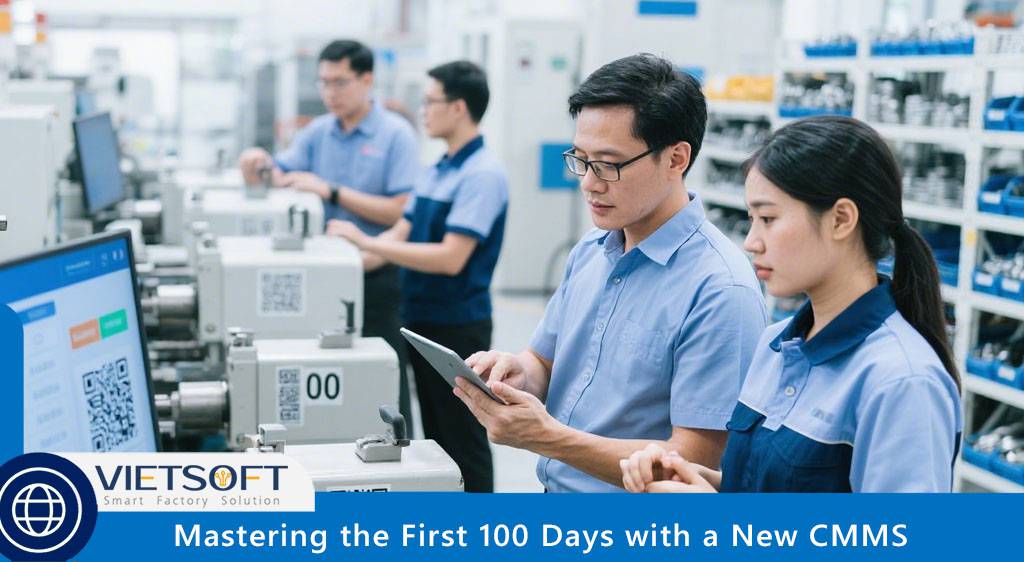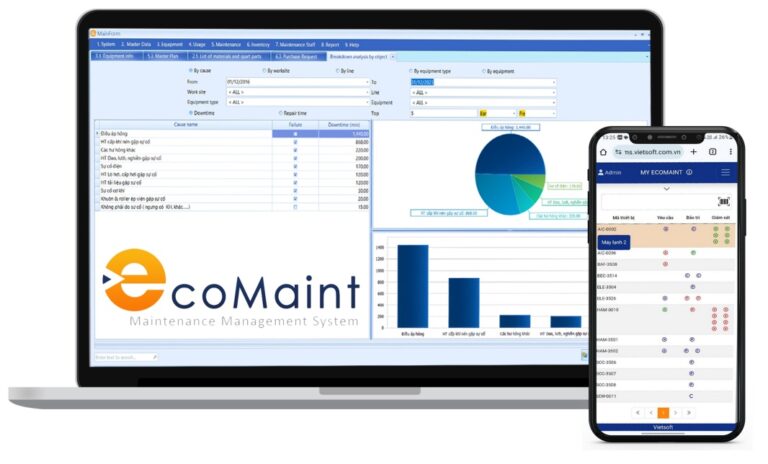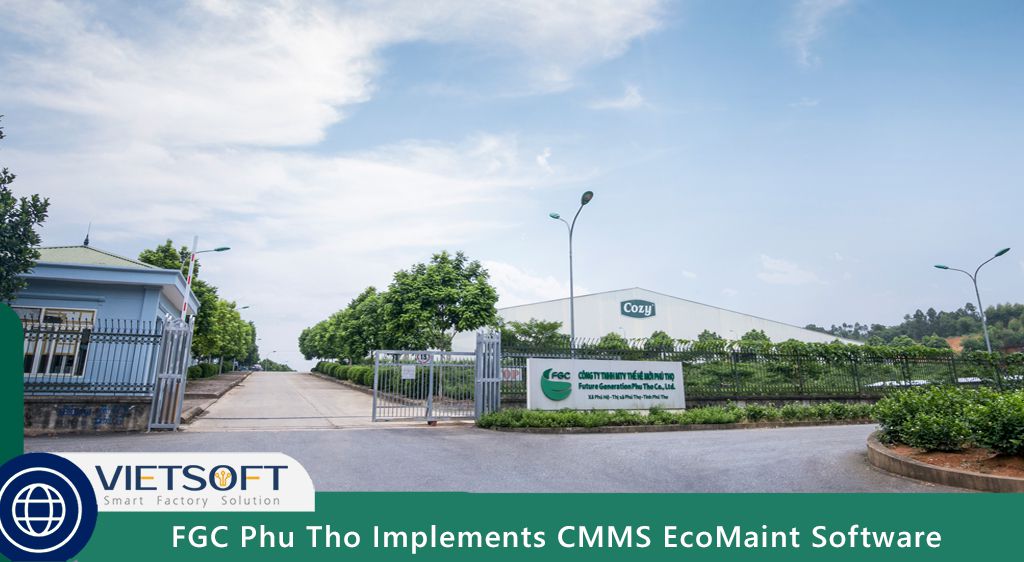
Embarking on the journey of implementing a new Computerized Maintenance Management System (CMMS) can transform how industrial facilities manage maintenance, streamline operations, and boost efficiency. The initial 100 days with a new CMMS are critical—they set the stage for long-term success or potential pitfalls. This guide dives deep into what CMMS software entails, its pivotal role in maintenance management, and a detailed blueprint for navigating your first 100 days with a new CMMS. Let’s explore how to maximize value, overcome hurdles, and build a robust foundation for your maintenance team.
I. What is CMMS Software and Why Does It Matter?
CMMS software, or Computerized Maintenance Management System, is a powerful tool designed to streamline maintenance operations in industrial settings. It acts as a centralized platform to schedule maintenance tasks, track asset performance, manage inventory, and generate insightful reports.
1. For maintenance professionals:
CMMS’s more than just software—it’s a game-changer that reduces downtime, optimizes resource allocation, and enhances safety by ensuring equipment is regularly serviced.
2. From a technician’s perspective:
CMMS software eliminates the chaos of paper-based records and manual processes. Imagine a scenario where a critical machine breaks down. With CMMS, you can quickly access its maintenance history, identify recurring issues, and order parts—all within minutes. This efficiency not only saves time but also prevents costly unplanned outages.
3. For managers:
the system provides data-driven insights, helping them make informed decisions about asset investments and workforce planning. In essence, CMMS software bridges the gap between people, processes, and technology, making it indispensable for modern industrial maintenance.
II. The Importance of a Blueprint for 100 Days with a New CMMS
A well-crafted blueprint for your first 100 days with a new CMMS ensures a smooth transition and early wins that build momentum. Without a plan, organizations risk low adoption rates, data mismanagement, and frustration among teams. The blueprint serves as a roadmap, outlining key milestones, addressing potential challenges, and aligning the implementation with your facility’s unique needs.
42% of CMMS implementation challenges stem from getting technicians and personnel on board, highlighting the human element of this process. Similarly, 27% of issues arise from planning and organizing the transition, while data migration and technical difficulties each account for 27% and 22%, respectively. These statistics underscore the need for a structured approach that tackles both technical and cultural aspects. A 100-day plan helps mitigate these risks by setting clear goals, providing training, and fostering team buy-in from day one.
III. Preparing for Success Before the 100 Days Begin
Before launching your 100 days with a new CMMS, laying a solid foundation is essential. This phase involves strategic planning and stakeholder engagement to ensure a successful rollout.
- Secure Buy-In Across All Levels: Engage senior leaders who control budgets and technicians who will use the system daily. Involve them in vendor selection and planning to create advocates who champion the change.
- Prioritize Training and Communication: Conduct role-specific training sessions before go-live. For example, technicians might need hands-on practice with work order entry, while managers focus on reporting tools. Early familiarity accelerates adoption.
- Clean and Centralize Data: Gather accurate data on assets, maintenance procedures, and inventory. A common mistake is migrating outdated or duplicate records, which can derail the process. Start with critical equipment data to build a reliable base.
- Define Goals and KPIs: Set measurable objectives, such as achieving 70% work order completion in the CMMS within 60 days or reducing downtime by 15%. Identify risks like resistance to change and plan contingencies.
- Assign Clear Roles: Designate a CMMS implementation lead, configuration experts, and training coordinators. Clear ownership prevents overlap and ensures accountability.
- Leverage Vendor Support: Work closely with your CMMS provider for data imports and workflow setup. Their experience can save weeks of trial and error.
- Digitize Key Processes: Convert paper-based standard operating procedures (SOPs) and checklists into digital formats. Focus on high-priority equipment to maximize early impact.
This preparation phase turns potential obstacles into stepping stones, setting the stage for a productive 100 days with a new CMMS.
IV. Key Strategies to Avoid Pitfalls During the First 100 Days
The first 100 days with a new CMMS are about building momentum, not perfection. Avoiding common missteps can make or break your implementation.
- Avoid Overloading Your Team: Resist the urge to configure every feature at once. Start with basic work orders and expand gradually to prevent overwhelm.
- Put People First: Neglecting training or feedback can lead to workarounds, undermining the system. Regularly check in with technicians to address their concerns.
- Focus on Progress, Not Perfection: Begin with a single asset or procedure. Each completed task is a victory that builds confidence.
- Treat It as a Transformation: CMMS isn’t just software—it reshapes how maintenance is planned and executed. Involve all departments to align processes with the new system.
By sidestepping these pitfalls, you create a positive experience that encourages long-term use.
V. Defining Success in Your 100 Days with a New CMMS
Success during the first 100 days with a new CMMS hinges on clear goals and measurable outcomes. Tailor these to your facility’s size, industry, and objectives.
- Adoption Rate: Aim for 70-80% of maintenance tasks logged in the CMMS. Track work orders completed and requests submitted digitally.
- Data Onboarding: Target adding 50% of assets and procedures within the first 30 days. Prioritize critical equipment to ensure quick wins.
- Training Completion: Ensure 90% of the team completes required training hours. This boosts confidence and usage.
- User Feedback: Implement at least five suggestions from technicians within 60 days to refine workflows.
- Maintenance Metrics: Aim to reduce mean time to repair (MTTR) by 10% or downtime by 15% using initial data.
For instance, a sample dashboard might show: Assets added (goal: 40, progress: 26, 65%), PMs added (goal: 100, progress: 87, 87%), and Downtime reduction (goal: 20%, progress: 17%). These metrics provide a snapshot of progress and highlight areas needing attention.
VI. A Detailed Day-by-Day Plan for 100 Days with a New CMMS
This plan breaks the 100 days into actionable sprints, adaptable to your facility’s needs. Let’s dive into each phase with actionable steps, tips, and real-world considerations to guide you through this critical journey:
1. Days 1-5: Setup and Foundation
The initial days are all about establishing a solid starting point. Begin by configuring system access, assigning user roles such as administrators, technicians, and maintenance requesters, and setting permissions to ensure data security and role clarity. For example, technicians might need access to work order updates, while managers require reporting privileges.
Next, focus on configuring locations and assets. Start by inputting your most production-critical assets—those with the highest downtime impact or frequent maintenance needs. Use a consistent naming convention, such as “Pump-001-AssemblyLineA,” to avoid confusion later. Create a basic asset hierarchy (e.g., Plant > Line > Machine) to organize data efficiently. If your facility has hundreds of assets, prioritize the top 10% based on maintenance history or criticality.
To familiarize yourself with the system, create test procedures, preventive maintenance (PM) tasks, and parts entries. These don’t need to be active yet—use them to experiment with fields like checklists, estimated times, or part associations. For instance, set up a test PM for a conveyor belt with a checklist including “Inspect rollers” and “Lubricate bearings.” This hands-on approach helps you understand the CMMS’s capabilities and prepares you for scaling up.
Tip: Document any issues encountered during setup (e.g., slow data entry) and share them with your vendor for quick resolution.
2. Days 5-10: Launch Primary Workflows
With the foundation in place, shift to building and launching primary procedures and workflows. Identify which procedures and PMs to prioritize—consider starting with high-frequency tasks or those tied to critical assets. For example, if your facility relies on a packaging machine, create a detailed procedure with steps like “Check belt tension,” “Replace worn parts,” and “Record runtime.” Include mandatory fields (e.g., technician sign-off) and attach relevant SOPs or images for clarity.
Configure select parts associated with these procedures. Add details like part names (e.g., “Bearing-6205”), storage locations (e.g., Warehouse-Bin-12), minimum stock levels (e.g., 5 units), and costs. Associate these parts with assets and procedures to streamline work order creation. For instance, link the “Bearing-6205” to the packaging machine’s PM.
Finally, build and assign your first work orders. Start with simple PMs, assigning them to technicians with estimated completion times (e.g., 2 hours) and priority levels (e.g., High). Enable notifications to alert admins and technicians of due dates or updates. Test the workflow by assigning a work order to a small team and reviewing their feedback on usability.
Consideration: If technicians struggle with the interface, schedule a quick refresher session to address specific pain points.
3. Days 10-20: Expand Operations
This phase expands the CMMS’s use to cover a broader range of maintenance activities. Configure recurring PMs for critical equipment, such as weekly inspections for a compressor. Use the system’s scheduling feature to set frequencies (e.g., every 7 days) and assign tasks to specific shifts or technicians. As you progress, add more assets, procedures, and parts to the schedule, ensuring a gradual but steady buildup.
Introduce non-planned work orders to handle reactive maintenance. When a machine fails unexpectedly, create a work order on the fly, adding any missing assets or parts as needed. For example, if a motor burns out, log the asset “Motor-003” and associate it with a repair procedure. Fine-tune these entries later to maintain data integrity.
Launch external maintenance requests to involve non-maintenance staff, such as operators or production leads. Configure a request portal with fields like “Issue Description” and “Urgency Level,” and set up routing rules to assign requests to the right team. Test the process by having an operator submit a sample request and track its progression.
Insight: Monitor response times for reactive work orders—aim to reduce them by 10-15% as a measurable early win.
4. Days 21-30: Refine and Report
Refinement is key to ensuring the CMMS becomes a daily tool. Create QR codes for assets to link directly to work orders, procedures, and SOPs. Print and affix these codes (e.g., on a pump’s control panel) to enable technicians to access information via mobile devices instantly. This reduces downtime during urgent repairs.
Enhance parts data by adding vendor contacts, reorder points (e.g., order 10 units when stock hits 5), and warranty details. For example, update “Bearing-6205” with a vendor phone number and a 6-month warranty. This prepares your inventory for automated reordering later.
Tag work orders with categories like “Preventive,” “Corrective,” or “Failure Type” to segment data for analysis. Build baseline reports using the CMMS’s dashboard tools, tracking metrics such as open vs. completed work orders, PM compliance (e.g., 85% completion rate), and downtime costs. Share these reports with the team to highlight progress.
Best Practice: Schedule a 30-minute review session with technicians to gather input on report usability.
5. Days 31-40: Assess and Adjust
Evaluate adoption and usage by analyzing login frequency, work order completion rates, and external requests processed. If 20% of tasks are still handled outside the CMMS (e.g., via paper), investigate why—common reasons include unclear workflows or lack of training—and address them with targeted support.
Refine processes based on feedback. If technicians report too many notification alerts, adjust settings to reduce non-critical updates. Identify underused features, such as mobile app analytics, and plan their introduction if they align with your next 60-day goals. Avoid distractions by focusing only on high-impact capabilities.
Communicate wins to boost morale. For example, if MTTR dropped from 4 hours to 3.5 hours, share this with senior leaders and the team via a brief email or meeting. Recognition reinforces the CMMS’s value and encourages continued use.
Key Metric: Aim for a 10% increase in adoption rate during this period as a sign of successful adjustment.
6. Days 41-60: Full Transition
Complete the transition by migrating all remaining assets, procedures, PMs, and parts into the CMMS. Close out legacy systems like spreadsheets or outdated software to ensure full reliance on the new platform. For instance, if you’ve been tracking parts in Excel, import the final dataset and verify its accuracy.
Connect related workflows by linking procedures and PMs to their respective assets or work orders. For example, tie a “Monthly Inspection” PM to “Conveyor-001” and ensure all associated parts are listed. This integration streamlines task execution and data retrieval.
Caution: Test the migrated data with a small pilot group before full deployment to catch errors early.
7. Days 61-80: Optimize and Automate
Enhance data insights by expanding tagging and categorization. Add custom tags like “High-Risk Asset” or “Recurring Failure” to work orders and PMs for better root cause analysis. For example, tag all work orders related to a specific pump failure to identify patterns.
Introduce multi-asset workflows for tasks like facility-wide cleanings or safety inspections. Build a procedure that applies to multiple machines, assigning it to a team rather than a single asset. Set up conditional logic to automate actions—e.g., trigger a purchase order when part stock falls below the minimum level.
Optimize work orders by adding fields for time tracking, part usage, and technician notes. Ensure digital sign-offs are mandatory to maintain accountability. Digitize any remaining paper SOPs, attaching them to relevant assets or procedures for easy access.
Expand reporting with advanced dashboards, such as “Cost per Asset” or “Time by Work Type.” Audit existing reports to identify gaps and add new ones based on team needs. Continue monitoring adoption, offering refresher training to low-usage users.
Example: If a technician logs in only 20% of expected time, schedule a one-on-one session to troubleshoot barriers.
8. Days 81-94: Integrate Systems
Identify minimum viable product (MVP) integrations, such as connecting the CMMS to an ERP for inventory updates or an IoT sensor for real-time asset data. Start with low-risk, out-of-the-box options to minimize disruption.
Work with your IT team and vendor to execute these integrations. For instance, link the CMMS to a purchasing system to automate part orders when stock levels drop. Test the integration with a small dataset (e.g., 10 parts) before scaling up.
Advice: Document integration steps and outcomes to streamline future expansions.
9. Days 95-99: Plan for the Next 100 Days
Set goals for the next phase, such as reducing downtime by 20% or expanding the CMMS to a second site. Define success metrics, like achieving 90% PM compliance across all assets. Chart a future for maintenance reporting, planning monthly reviews of key performance indicators (KPIs) with leadership.
Prepare to scale by identifying workflows to replicate (e.g., work order management) and stakeholders to involve (e.g., new site managers). Outline optimization points, such as transitioning to condition-based maintenance using sensor data or pursuing advanced AI integrations.
Strategy: Host a planning workshop with key team members to align on priorities.
10. Day 100: Celebrate Your Wins
Mark this milestone with a celebration to recognize the team’s hard work. Share success stories, such as a 15% downtime reduction or 80% adoption rate, via a company-wide announcement or event. Reward top adopters with certificates or small incentives to sustain motivation.
Reflection: Use this day to gather final feedback and plan a post-100-day review schedule.
VII. Maximizing Value After 100 Days with a New CMMS
Beyond the initial 100 days, the focus shifts to optimization and integration. Adopt a plan-do-check-act cycle: set quarterly goals, implement changes, monitor via dashboards, and adjust based on results. Translate maintenance data into business value by sharing downtime reductions with leaders or equipping technicians with performance dashboards. Foster collaboration by incorporating technician feedback into regular meetings, and pursue integrations with ERP or IoT systems to deepen the CMMS’s impact.
VIII. Introducing CMMS EcoMaint by Vietsoft: Your Partner in Maintenance Excellence
As you navigate your 100 days with a new CMMS, consider the transformative potential of CMMS EcoMaint, developed by Vietsoft. Tailored for the Vietnamese market, this cloud-based solution simplifies maintenance management with intuitive features and robust support. Curious about how EcoMaint can elevate your operations? Discover the CMMS EcoMaint solution here.
Contact us for consultation via hotline: 0986778578 or email: sales@vietsoft.com.vn.
IX. Conclusion
The first 100 days with a new CMMS are a pivotal period to establish a culture of efficiency and data-driven maintenance. By understanding CMMS software’s role, preparing thoroughly, and following a detailed blueprint, you can overcome challenges and unlock significant value. Keep refining your approach, celebrate milestones, and consider innovative solutions like CMMS EcoMaint to stay ahead. Your journey to maintenance excellence starts now—make it count!




